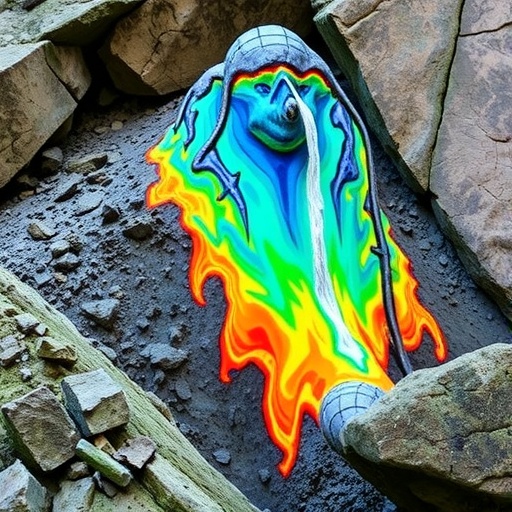In recent years, the challenge of accurately mapping rockfall susceptibility has grown in importance as urbanization and infrastructure development increasingly encroach upon mountainous and rocky terrains. A breakthrough paper published in Environmental Earth Sciences introduces a novel approach that could revolutionize how geologists and engineers predict areas vulnerable to rockfall events. Researchers Yassine El Miloudi, Youssef El Kharim, and Rachid El Hamdouni present a sophisticated technique that harnesses the power of transfer learning, blending machine learning models with traditional statistical methods to yield unprecedented precision in rockfall susceptibility mapping.
Rockfalls represent one of the most unpredictable and hazardous natural phenomena, capable of causing significant damage to roads, railways, and habitations nestled near rocky escarpments. Historically, susceptibility mapping has relied on either empirical observations or isolated modeling techniques that often lack the generalized adaptability to various geological contexts. This newly proposed framework bridges the gap by leveraging the complementary strengths of boosting algorithms — known for their powerful pattern recognition capabilities — and logistic regression, a stalwart statistical method prized for interpretability and robustness.
The core innovation lies in the integration of transfer learning, a machine learning paradigm allowing knowledge gained from one domain or dataset to improve predictive accuracy in another, related domain. In the context of rockfall susceptibility, this means models trained on one geological region with abundant labeled rockfall data can be adapted to other regions with limited or sparse datasets. This is particularly beneficial since acquiring comprehensive ground-truth rockfall data is often logistically challenging and financially prohibitive.
Boosting algorithms, such as Gradient Boosting Machines (GBMs) and Extreme Gradient Boosting (XGBoost), have demonstrated efficacy in handling complex, nonlinear relationships within environmental variables. Yet, their ‘black-box’ nature often undermines practical application, as stakeholders prefer transparent models with understandable decision boundaries. By transferring insights from these boosting models into logistic regression frameworks, the researchers create hybrid models that are both highly predictive and interpretable, allowing engineers and planners to comprehend why specific areas are flagged as susceptible.
To validate their methodology, the authors employed a detailed case study encompassing a mountainous region characterized by a variety of lithologies, rugged slopes, and climatic conditions conducive to frequent rockfalls. Geological covariates such as slope angle, aspect, lithological type, and evidence of fracture zones were incorporated as predictors. In addition, geomorphological and environmental parameters were systematically analyzed, enriching the model’s contextual understanding of rockfall dynamics.
The resulting models were benchmarked against traditional susceptibility maps generated without transfer learning. The hybrid models notably outperformed these baselines, achieving higher Area Under Curve (AUC) scores and reduced false-positive rates. These improvements indicate that incorporating transferred knowledge allows for more reliable delineation between high-risk and low-risk zones, facilitating better-informed risk mitigation strategies.
The article also delves into the implications of this approach in the realm of risk management and infrastructure resilience. By providing accurate, readily interpretable susceptibility maps, stakeholders can strategically allocate resources for slope stabilization, monitor critical areas more effectively, and design safer infrastructure layouts. Moreover, this modeling framework is readily extendable to other geomorphological hazards, such as landslides and debris flows, where data scarcity similarly hampers forecasting efforts.
An important technical aspect discussed is the optimization of transfer learning parameters to prevent negative transfer, where knowledge from one domain might degrade predictive performance in the target region. Through careful feature selection, domain adaptation techniques, and hyperparameter tuning, the researchers mitigate this risk, ensuring the robustness of their models under varied geological scenarios. This methodological rigor sets a new standard for the application of machine learning in earth sciences.
Furthermore, the interpretability of logistic regression allows for the generation of explicit susceptibility coefficients, mapping directly to physical processes. For instance, the model quantifies how increasing slope angles or proximity to fault lines statistically amplifies rockfall probability. This clarity enables geologists to trust model outputs, fostering a symbiotic relationship between data-driven insights and experiential knowledge.
Beyond technical merits, the publication emphasizes the multidisciplinary cooperation required to harness such advanced modeling — involving geologists, data scientists, and engineers. This collaborative approach underscores the evolving nature of environmental risk assessment, where computational science and traditional geology intersect to produce practical solutions addressing real-world dangers.
Looking ahead, the researchers advocate for integrating real-time sensor data and satellite imagery into their transfer learning framework, potentially opening the door to near-instantaneous rockfall susceptibility updates. Such dynamic models would be invaluable for emergency response systems, especially in heavily trafficked mountainous infrastructures vulnerable to sudden geohazards.
The paper also contributes to a broader scientific conversation on the ethical use of artificial intelligence in environmental monitoring. Transparency, replicability, and stakeholder involvement remain pivotal themes that guide the responsible deployment of these models in public safety contexts.
In conclusion, this pioneering work by El Miloudi, El Kharim, and El Hamdouni reflects a significant advancement in hazard mapping methodologies. By fusing sophisticated machine learning techniques with the transparency of logistic regression through transfer learning, they deliver a practical toolset that promises to improve risk prediction efficacy and ultimately save lives and property. The ripple effects of this approach extend beyond rockfall susceptibility, heralding a new era for geohazard modeling and environmental risk management.
The scientific community and industry stakeholders alike will be watching closely as this technology matures and scales, providing a glimpse into how AI-driven insights can fortify our defenses against the unpredictable forces of nature. As geologists grapple with growing environmental uncertainties, such interdisciplinary innovations offer a beacon of hope for resilient and safer mountain communities worldwide.
Subject of Research: Rockfall susceptibility mapping using machine learning transfer learning techniques and logistic regression.
Article Title: A novel approach for rockfall susceptibility mapping: Transfer learning between boosting models and logistic regression.
Article References:
El Miloudi, Y., El Kharim, Y. & El Hamdouni, R. A novel approach for rockfall susceptibility mapping: Transfer learning between boosting models and logistic regression. Environmental Earth Sciences 84, 447 (2025). https://doi.org/10.1007/s12665-025-12437-4
Image Credits: AI Generated




